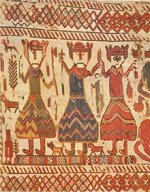IronSide
Elite member
- Messages
- 883
- Reaction score
- 279
- Points
- 0
- Y-DNA haplogroup
- I2c2
- mtDNA haplogroup
- T2e1
All Indo-European cultures had three castes :
1-Priests
2-Warriors/Nobles
3-Farmers/Tradesmen/Commoners
Examples of the Indo-European castes:
The situation in Gaul was so severe and is documented by Caesar in his "Gallic Wars" http://penelope.uchicago.edu/Thayer/E/Roman/Texts/Caesar/Gallic_War/6B*.html
"Throughout Gaul there are two classes of persons of definite account and dignity. As for the common folk, they are treated almost as slaves, venturing naught of themselves, never taken into counsel. The more part of them, oppressed as they are either by debt, or by the heavy weight of tribute, or by the wrongdoing of the more powerful men, commit themselves in slavery to the nobles, who have, in fact, the same rights over them as masters over slaves. Of the two classes above mentioned one consists of Druids, the other of knights."
I would definitely not want to be a peasant.
1-Priests
2-Warriors/Nobles
3-Farmers/Tradesmen/Commoners
Examples of the Indo-European castes:
- Indo-Iranian – Brahmin/Athravan, Kshatriyas/Rathaestar, Vaishyas
- Roman – Flamines, Milites, Quirites
- Celtic – Druids, Equites, Plebes
- Anglo-Saxon – Gebedmen (prayer-men), Fyrdmen (army-men), Weorcmen (workmen)
- Slavic – Volkhvs, Voin, Krestyanin/Smerd
- Nordic – Earl, Churl, Thrall
- Greece (Attica) – Eupatridae, Geomori, Demiurgi
- Greece (Sparta) – Homoioi, Perioeci, Helots
The situation in Gaul was so severe and is documented by Caesar in his "Gallic Wars" http://penelope.uchicago.edu/Thayer/E/Roman/Texts/Caesar/Gallic_War/6B*.html
"Throughout Gaul there are two classes of persons of definite account and dignity. As for the common folk, they are treated almost as slaves, venturing naught of themselves, never taken into counsel. The more part of them, oppressed as they are either by debt, or by the heavy weight of tribute, or by the wrongdoing of the more powerful men, commit themselves in slavery to the nobles, who have, in fact, the same rights over them as masters over slaves. Of the two classes above mentioned one consists of Druids, the other of knights."
I would definitely not want to be a peasant.



